Your cart is currently empty!
In this post, you will learn to use this interior design style guide to identify a style that reflects your unique self.
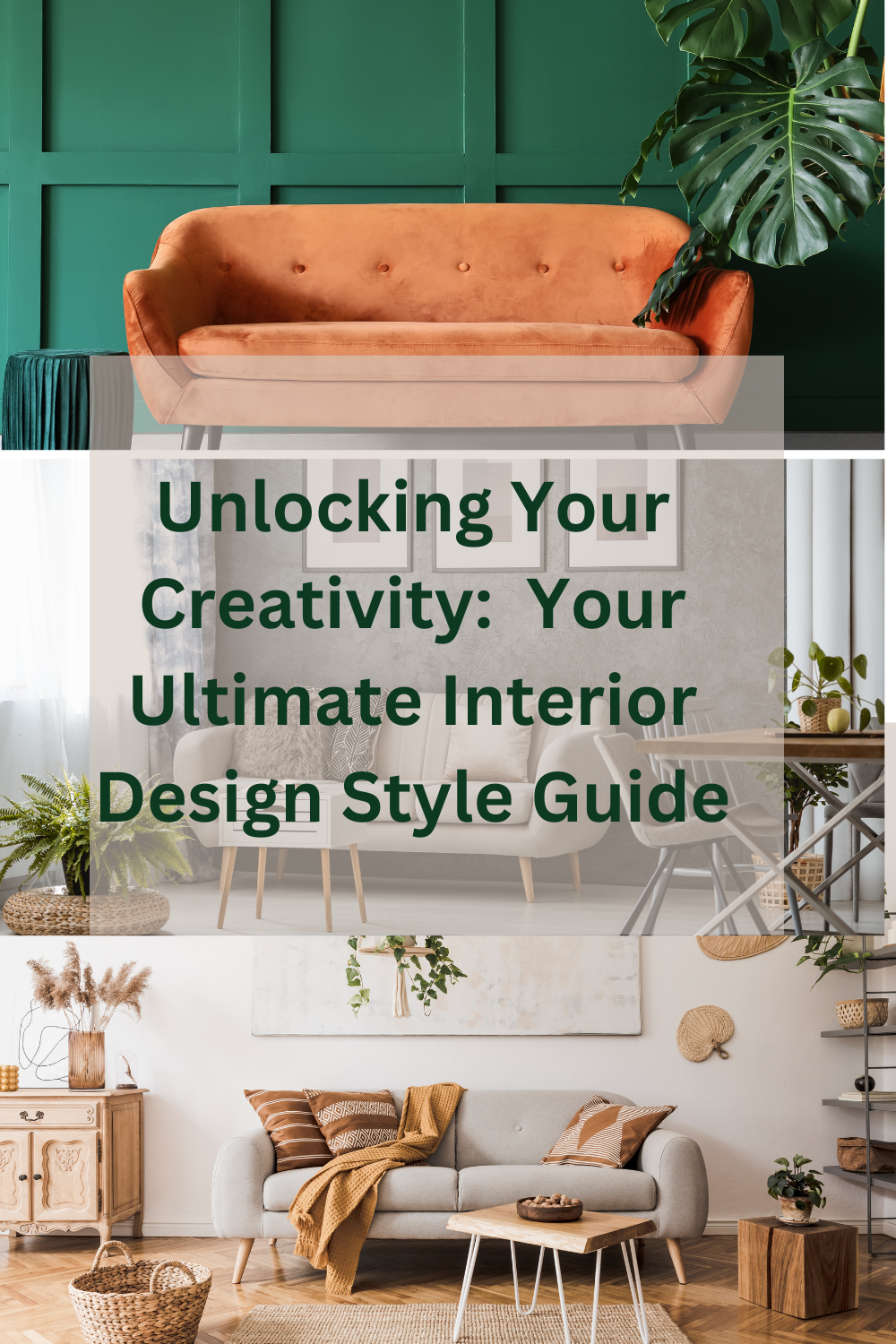
This interior design style guide aims to help you identify your decorating style so you can shop wisely for furniture and home decor accessories.
When you shop with intention, you will be guided in creating a space that reflects your unique self.
This post is about learning about the different interior design styles. It will help you identify your decorating style and achieve your desired look.
Your Ultimate Interior Design Style Guide
Mid-century Interior
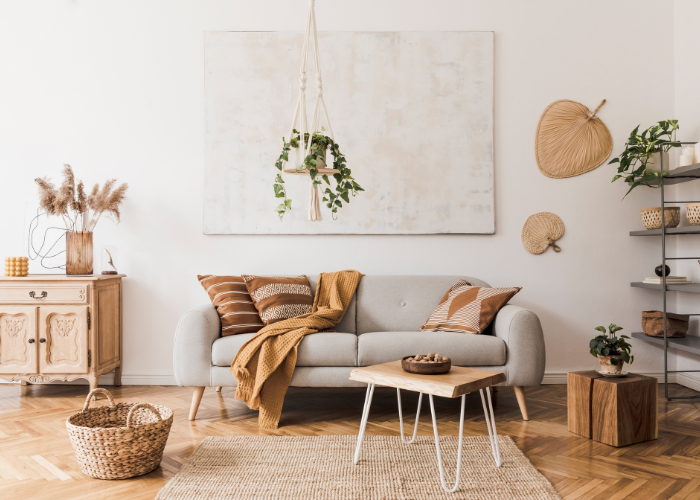
A clean, minimalist aesthetic focusing on functionality and an integration of nature characterizes mid-century modern interior design.
Because of its origin in the mid-20th century, particularly in the 1950s and 1960s, this style is known for its sleek lines, organic shapes, and innovative materials.
From this interior design guide, here are key elements used to create a mid-century modern interior design:
Clean Lines and Minimalism:
- Mid-century design emphasizes clean, straight lines and a minimalist approach.
- Minimalist designs often create sleek and uncluttered furniture and architectural elements.
Organic Forms:
- Incorporation of organic, natural shapes and forms is a prominent feature.
- Furniture pieces may have gentle curves, and geometric patterns often mimic natural elements.
Functional Furniture:
- Furniture in mid-century design is known for its functionality and practicality.
- Pieces serve multiple purposes and storage solutions to integrate into the design.
Iconic Furniture Designs:
- Mid-century modern design is associated with iconic furniture designs by designers like Charles and Ray Eames, Eero Saarinen, and Arne Jacobsen. Examples include the Eames Lounge Chair, Saarinen Tulip Table, and Jacobsen’s Egg Chair.
Use of Wood:
- Natural materials are essential in mid-century interiors, and wood is preferred. For example, use teak, walnut, and oak for furniture, flooring, and paneling.
- Bold Colors:
- A Mid-century style frequently uses vibrant and bold colors, such as avocado green, mustard yellow, and orange. Therefore, these colors add a playful and energetic element to the design.
Mix of Materials:
- Besides wood, mid-century design incorporates a mix of metal, glass, and plastic materials. And steel, chrome, and glass are often used for furniture and lighting fixtures.
Mid-century Art and Accessories:
- Artwork from the mid-century period and accessories like ceramics, abstract sculptures, and vintage clocks contribute to the overall aesthetic of the design.
Industrial Interior Style
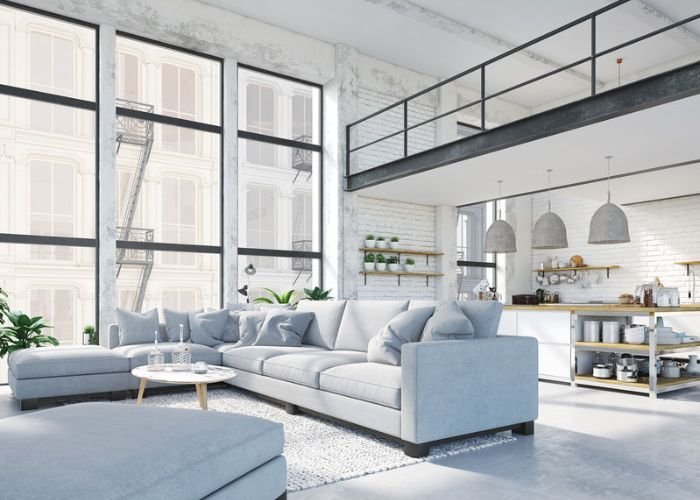
Industrial interior design draws inspiration from factories and warehouses’ raw, utilitarian aesthetics.
This style often emphasizes exposed structural elements, a mix of materials, and a rugged, unpolished look. Specifically, the interior design style guides critical components used to create an industrial interior design style:
Exposed Structural Elements:
- Exposed structural elements, such as beams, ductwork, and pipes, are one of the main characteristics of this design. Also, the industrial feature provides a sense of authenticity and a raw, unfinished look.
Raw Materials:
- Use raw and natural materials like brick, concrete, steel, and reclaimed wood.
- These materials contribute to the industrial aesthetic and showcase the building’s original features.
Open Spaces:
- Embrace open floor plans with minimal dividing walls.
- This creates a spacious, loft-like feel commonly associated with industrial interiors.
Concrete Floors:
- Opt for concrete floors or other industrial-looking flooring options like polished or stained concrete.
- These flooring choices are durable and enhance the industrial vibe.
Metal Accents:
- Incorporate metal elements like steel frames, iron railings, and metal light fixtures.
- Metal can add an edgy and valuable touch to the space.
Large Windows:
- Install large windows to maximize natural light and provide an open, airy atmosphere.
- Factory-style windows or steel-framed windows are standard in industrial design.
Vintage and Repurposed Furniture:
- Choose furniture with an industrial or vintage aesthetic.
- Pieces made from reclaimed wood or metal and furniture with a worn or distressed appearance fit well into industrial interiors.
Industrial Lighting:
- Select lighting fixtures with an industrial look, such as pendant lights with metal shades, Edison bulbs, or exposed bulb fixtures.
- Industrial lighting often serves as both functional and decorative elements.
Utilitarian Decor:
- Decorative items with a functional or factory-inspired design contribute to the industrial style. Examples include old factory gears, gears, pulleys, and vintage signage.
Mechanical Details:
- Incorporate mechanical and functional details, such as exposed bolts, gears, and hardware, to enhance the industrial look.
Utilitarian Fabrics:
- Choose fabrics with a utilitarian feel, such as canvas, burlap, or leather.
- Such fabrics can be used for upholstery, throw pillows, or curtains, adding texture and authenticity to the space.
Minimalist Interior Style
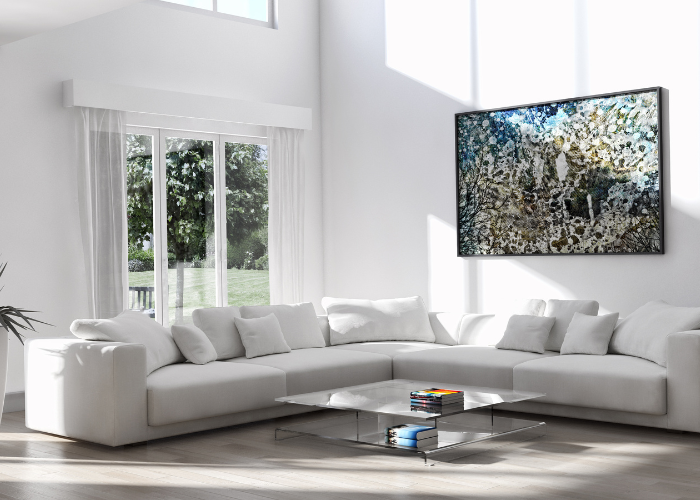
Simplicity, clean lines, and a focus on functionality characterize minimalist interior design. The goal is to create a space that feels uncluttered, serene, and purposeful.
In this interior design style guide are critical elements used to create a minimalist interior design style:
Neutral Color Palette:
- Choose a neutral color palette with white, beige, gray, and black tones. Also, the use of neutrals helps create a calm and discreet atmosphere.
Clean Lines and Simple Shapes:
- Emphasize clean, straight lines and simple geometric shapes in furniture and architectural elements. Avoid excessive decor ornamentation or intricate details.
Open and Uncluttered Spaces:
- Keep spaces open and uncluttered by minimizing the number of furniture pieces and decor items.
- Each element in the room should have a purpose and contribute to the overall aesthetic.
Functional Furniture:
- Select furniture that serves a specific purpose and is free of unnecessary embellishments.
- Multi-functional furniture and hidden storage solutions can help maintain a clutter-free environment.
Limited Decor:
- Limit the number of decorative items in the space.
- Choose a few carefully selected pieces that have significance or provide visual interest without overwhelming the simplicity of the design.
Monochromatic Color Schemes:
- Opt for monochromatic color schemes to maintain visual coherence.
- This involves using different shades of a single color or closely related colors for a harmonious look discussed here.
High-Quality Materials:
- Use high-quality natural wood, stone, glass, and metals. Remember, the emphasis is on the beauty of the materials rather than intricate patterns or embellishments.
Empty Wall Spaces:
- Allow for empty wall spaces to maintain a sense of openness. If artwork is displayed, it is often simple and placed strategically as a focal point.
Limited Textures:
- Keep textures minimal and cohesive.
- Smooth surfaces like polished concrete or smooth wood are joined in minimalist interiors. Meanwhile, textural elements, if included, are subtle.
De-cluttered Surfaces:
- Avoid clutter on surfaces like countertops and tables. A minimalist design seeks to maintain a sense of order and simplicity, so only essential items should be on display.
Geometric Furniture Design:
- Furniture with clean and geometric shapes complements the minimalist style.
- Simple and unadorned pieces contribute to the streamlined aesthetic.
Emphasis on Functionality:
- Prioritize functionality in furniture and design choices.
- Each item should serve a purpose, and unnecessary elements should be minimized.
Traditional Interior Style
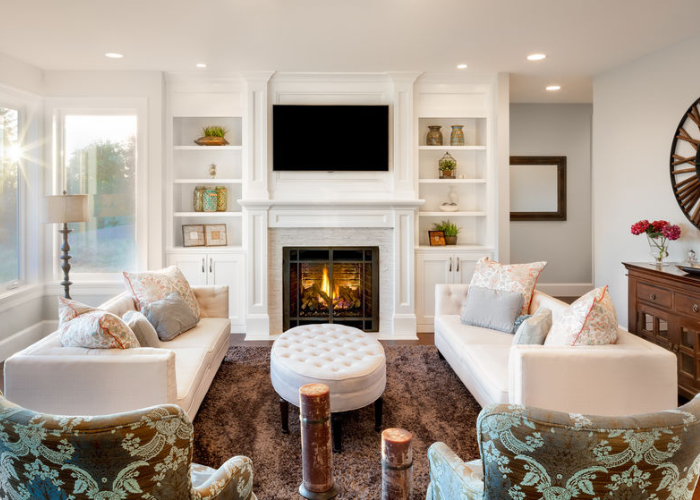
Traditional interior design is characterized by a classic and timeless aesthetic that draws inspiration from various historical periods. It often features elegant furnishings, rich colors, and ornate details.
In this interior design guide are some key elements commonly used to create a traditional interior design style:
Classic Furniture:
- Traditional interiors showcase furniture with timeless designs. This may include pieces with intricate woodwork, curved lines, and detailing such as claw feet or cabriole legs.
- Wingback chairs, camelback sofas, and Chippendale or Queen Anne-style furniture are ordinary.
Rich Materials:
- Traditional design favors high-quality materials like wood, leather, and silk.
- Dark woods like mahogany, cherry, and walnut are often used for furniture, while luxurious fabrics like damask, brocade, and velvet are chosen for upholstery.
Antique and Reproduction Pieces:
- Incorporating antique furniture or high-quality reproductions is a crucial characteristic of traditional interiors. These pieces contribute to the sense of history and craftsmanship.
Formal Window Treatments:
- Draperies, valances, and curtains with elaborate patterns or luxurious fabrics are typical in traditional design. They often feature pleats, tassels, or fringe details.
Symmetry and Balance:
- A sense of balance and symmetry characterizes traditional interiors.
- Matching pairs of furniture, accessories, and artwork contribute to a harmonious and orderly look.
Classic Patterns:
- Traditional design often incorporates classic patterns such as florals, stripes, damask, and plaids.
- These patterns are used in upholstery, drapery, and wallpaper to add visual interest.
Warm Color Palette:
- Traditional color schemes are generally warm and inviting. Earthy tones, deep reds, rich greens, and warm neutrals create a cozy and timeless atmosphere.
Molding and Millwork:
- Architectural details, including crown molding, chair rails, and wainscoting, are common in traditional interiors.
- These details add a sense of refinement and craftsmanship to the space.
Chandeliers and Elegant Lighting:
- Traditional interiors often feature ornate chandeliers and sconces.
- Lighting fixtures can be made of crystal, brass, or other high-quality materials, serving as focal points in the room.
Traditional Rugs:
- Oriental or Persian rugs with intricate patterns and rich colors are popular for traditional interiors.
- Rugs add warmth and sophistication to the space.
Classic Artwork and Portraits:
- Traditional interiors often include artwork with classic themes, such as landscapes, still life, or portraits.
- Gilt frames and traditional art pieces contribute to the overall elegance.
Formal Dining Sets:
- Traditional dining rooms typically feature formal dining sets with matching chairs and a coordinating table. China cabinets or buffets may be used to display fine china or silverware.
Fireplaces and Mantels:
- If the space allows, traditional interiors often include a fireplace with a mantel.
- The mantel may serve as a focal point and allow the displaying of decorative items.
Eclectic Interior Style

Eclectic interior design is characterized by various styles, influences, and periods, resulting in a unique and personalized look. The thoughtful combination of diverse elements is the key to achieving an eclectic style.
From this interior design style guide are some elements commonly used to create an eclectic interior:
Mix of Furniture Styles:
- Incorporate furniture pieces from different eras and styles.
- Pairing a modern sofa with a vintage coffee table or combining antique chairs with contemporary furnishings creates visual interest.
Varied Textures and Materials:
- Use a mix of textures and materials, such as wood, metal, glass, leather, and fabric.
- Combining diverse textures adds depth and dimension to the space.
Bold Colors and Patterns:
- Embrace a diverse color palette and experiment with bold patterns.
- Mix and match colors and patterns in upholstery, throw pillows, rugs, and wall coverings.
Artwork and Wall Decor:
- Display a diverse collection of artwork, including paintings, prints, and sculptures.
- Mix different styles and mediums to create an eclectic gallery wall. See my post on how to create a gallery wall.
Unique Lighting Fixtures:
- Choose distinctive lighting fixtures that stand out.
- Mixing styles like industrial pendant lights, vintage chandeliers, and contemporary floor lamps can add eclectic flair.
Mismatched Accessories:
- Incorporate a variety of accessories, such as vases, decorative bowls, and figurines. These can come from different styles and periods, contributing to the eclectic mix.
Vintage and Antique Finds:
- Incorporate vintage or antique pieces into the decor.
- These items can add character and history to the space, contributing to the eclectic aesthetic.
Layered Rugs and Textiles:
- Layering rugs of different patterns and textures adds visual interest to the floor.
- Mixing throw blankets and cushions in various fabrics enhances the eclectic feel.
DIY and Upcycled Elements:
- Integrate handmade or upcycled items into the design. DIY projects or repurposed furniture pieces can contribute to the eclectic, one-of-a-kind look.
Unexpected Color Combinations:
- Experiment with unexpected color combinations that might not typically go together.
- Eclectic interiors often celebrate the freedom to mix and match colors in unconventional ways.
Mix of Patterns and Textiles:
- Combine patterns, such as stripes, florals, and geometric prints.
- Mixing different textiles like silk, cotton, and wool adds a tactile and eclectic quality to the space.
Personalized Collections:
- Showcase personal collections, vintage cameras, vinyl records, or travel souvenirs.
- These collections add a unique and personal touch to the eclectic style.
Art Deco Design Style
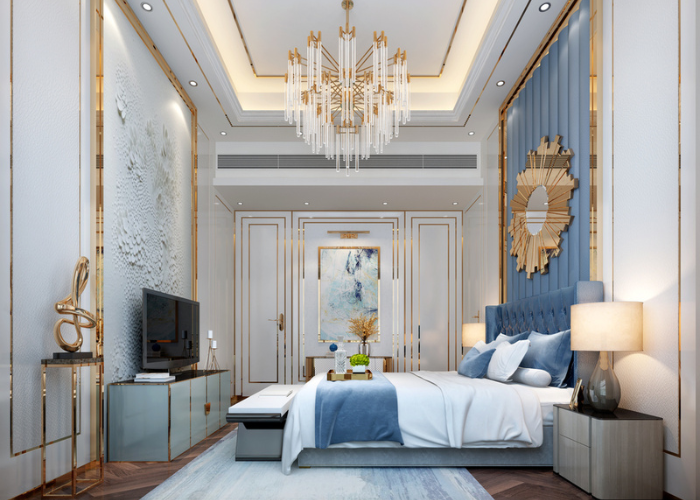
Art Deco interior design is characterized by a bold and glamorous aesthetic that emerged in the early 20th century, particularly during the 1920s and 1930s. This style is known for its emphasis on luxury, geometric shapes, and rich materials.
From this interior design style guide are some key elements used to create an Art Deco interior design:
Geometry and Symmetry:
- Art Deco relies heavily on geometric shapes, such as zigzags, chevrons, and stepped patterns.
- Symmetry is a fundamental aspect of Art Deco design, creating a sense of balance and order in the space.
Rich Materials:
- Luxurious and exotic materials are essential in Art Deco interiors.
- These include lacquer, chrome, glass, mirrors, inlaid wood, marble, and precious metals.
Bold Colors:
- The color palette is typically bold and vibrant, featuring high-contrast combinations.
- Popular colors include black, white, gold, silver, and jewel tones like emerald green, sapphire blue, and ruby red.
Streamlined and Elegant Furniture:
- Clean lines, smooth surfaces, and a sense of sophistication often characterize furniture in Art Deco interiors.
- Common furniture pieces include sleek sofas, club chairs, lacquered furniture, and mirrored or glass surfaces.
Decorative Patterns:
- Geometric patterns, including chevrons, zigzags, and stylized floral motifs, are common in Art Deco design.
- Exotic influences, such as Egyptian and African motifs, are also incorporated into the decorative elements.
Mirrors and Reflective Surfaces:
- Mirrored surfaces and reflective materials, like chrome and glass, are frequently used to enhance the sense of luxury and add a touch of glamour.
Bold Artwork:
- Art Deco interiors often feature bold and stylized artwork, including paintings, sculptures, and murals.
- The art may showcase the streamlined, geometric aesthetic of the overall design.
Marquetry and Inlay:
- Intricate patterns and designs created through marquetry (decorative wood inlay) are common in Art Deco furniture and decor.
Luxurious Fabrics:
- Fabrics used in Art Deco interiors are rich and sumptuous. Velvet, satin, and leather are popular choices, often featuring bold colors and geometric patterns.
Tropical and Exotic Influences:
- Some Art Deco designs incorporate elements inspired by exotic cultures, such as palm leaves, animal prints, and motifs from Africa and Egypt.
Transitional Design Style
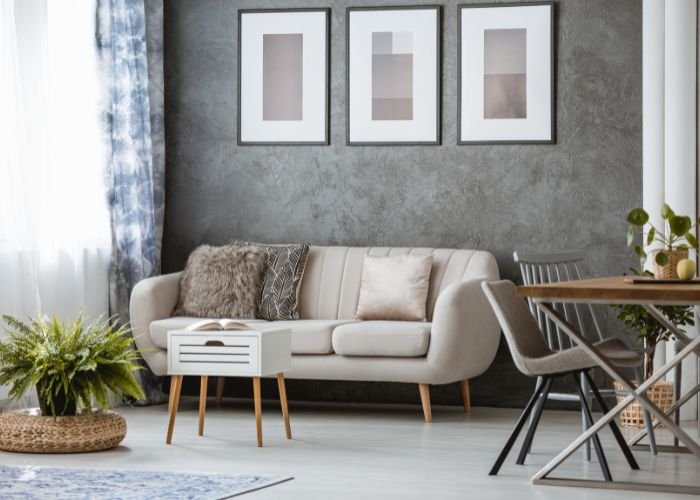
Transitional interior design is a balanced blend of traditional and contemporary styles, combining elements to create a timeless and harmonious aesthetic. The goal is to achieve a comfortable and welcoming space that avoids extremes.
Additionally, from the interior design style guide are key elements used to create a transitional interior design style:
Neutral Color Palette:
- Use a neutral color palette with warm tones, such as beige, taupe, and gray, providing a versatile backdrop and helping create a calming atmosphere.
Subtle Patterns:
- Incorporate subtle and understated patterns. Transitional interiors often feature geometric patterns or tone-on-tone designs that add visual interest without being too bold.
Mix of Materials:
- Integrate a mix of materials, combining both traditional and contemporary choices. For example, you might pair a classic wooden table with modern metal or acrylic chairs.
Comfortable and Functional Furniture:
- Choose comfortable and functional furniture with clean lines. Avoid overly ornate or overly streamlined pieces.
- Upholstered furniture tends to be plush and inviting.
Balance of Styles:
- Achieve a balance between traditional and contemporary styles.
- For instance, you might pair a classic sofa with more modern accent chairs or mix traditional architectural details with contemporary furnishings.
Softened Edges:
- Transitional design often features softened edges and curves.
- Furniture and architectural elements may have gentle curves that create a sense of warmth and comfort.
Limited Use of Decorative Accessories:
- Keep the use of decorative accessories moderate.
- Avoid excessive home decor accessories and focus on a curated selection of meaningful and well-chosen items.
Textured Fabrics:
- Incorporate textured fabrics for added warmth and interest.
- Soft textures like chenille or linen can be combined with smooth and sleek materials to achieve a balanced look.
Simple Window Treatments:
- Use simple and classic window treatments that enhance the natural light.
- Neutral drapes, Roman shades, or wooden blinds are common choices.
Versatile Lighting:
- Choose versatile lighting fixtures that blend traditional and contemporary elements.
- Transitional interiors often feature chandeliers with clean lines, pendant lights, or table lamps with neutral shades.
Artwork with Broad Appeal:
- Select artwork that has broad appeal and can bridge the gap between traditional and contemporary styles.
- Landscape paintings, abstract art, or photography are popular choices.
Neutral Area Rugs:
- Use neutral area rugs that complement the color scheme and add a layer of softness.
- Transitional interiors often feature rugs with subtle patterns or textures.
Open Layouts:
- Transitional interiors often embrace open layouts that create a sense of flow between home areas.
- This openness contributes to a modern and relaxed atmosphere.
Subdued Accents:
- Introduce accents in a restrained manner.
- A few carefully chosen accent pieces or pops of color can add interest without overwhelming the space.
Coastal Design Style

A coastal interior design style, also known as coastal or beach style, draws inspiration from the relaxed and breezy atmosphere of coastal living. It often incorporates natural elements, light colors, and a casual, comfortable vibe.
In the interior design style guide are critical characteristics used to create a coastal interior design style:
Light and Airy Color Palette:
- Use a light and airy color palette that reflects the coastal environment.
- Whites, soft blues, sandy beiges, and seafoam greens are common choices.
- These colors create a sense of openness and tranquility.
Natural Materials:
- Incorporate natural materials that evoke the beach and ocean.
- Examples include rattan, bamboo, jute, driftwood, and reclaimed wood.
- These materials add warmth and texture to the space.
Nautical Elements:
- Integrate nautical elements without going overboard. Stripes, especially blue and white stripes, are a classic choice.
- Nautical ropes, anchor motifs, and seashell decorations can also be used subtly and tastefully.
Casual and Comfortable Furniture:
- Choose furniture that is comfortable and inviting.
- Slip-covered sofas and chairs, often in white or light colors, create a relaxed atmosphere.
- Wicker or rattan furniture adds a touch of coastal charm.
Natural Light:
- Maximize natural light by using light and sheer window treatments.
- Allow the sunlight to flood the space, creating a bright and cheerful environment.
Seaside Accessories:
- Decorate with seaside accessories such as seashells, beach glass, and driftwood.
- Accessory items can be used sparingly as accents to evoke a coastal feel.
Ocean-Inspired Artwork:
- Hang artwork that reflects the ocean and beach scenes.
- Coastal landscapes, seascapes, and marine life artwork contribute to the theme.
Textured Fabrics:
- Use textured fabrics to add depth and interest.
- Linen, cotton, and other natural fabrics in light and breezy colors are suitable for coastal interiors.
Weathered and Distressed Finishes:
- Choose furniture with weathered or distressed finishes to evoke a sense of age and character.
- Include reclaimed wood furniture or pieces with a gently worn appearance.
Indoor-Outdoor Connection:
- Create a seamless indoor-outdoor connection using materials and decor that transition between indoor and outdoor spaces.
- This is especially effective in homes located near the coast.
Soft Area Rugs:
- Use soft area rugs that mimic the colors and textures of the beach.
- Natural fiber rugs like sisal or jute can add a coastal touch while providing a comfortable feel underfoot.
Coastal Plant Life:
- Integrate coastal plant life, such as palms, ferns, or other greenery.
- Potted plants or fresh flowers bring a touch of nature indoors.
Blue and White Color Scheme:
- Blue and white is a classic coastal design color scheme.
- It reflects the sky and sea colors, creating a fresh and timeless look.
Relaxed and Casual Vibe:
- Keep the overall atmosphere relaxed and casual.
- Coastal interiors are meant to be inviting and comfortable, reflecting the laid-back lifestyle associated with beach living.
Modern Contemporary Design Style
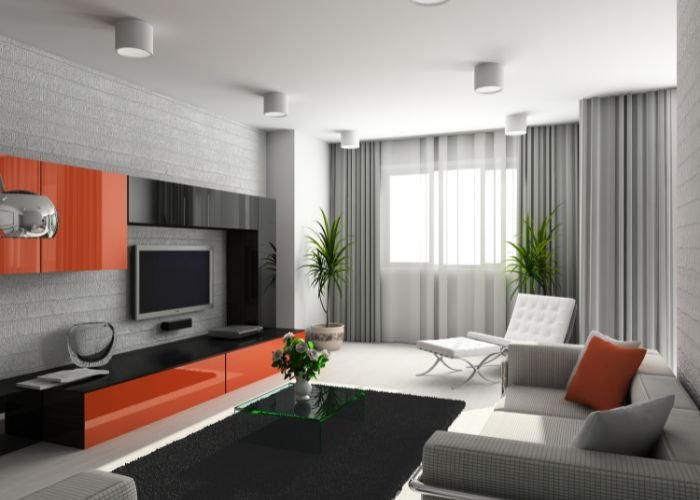
Modern contemporary interior design is characterized by clean lines, a focus on function, and a sleek, sophisticated aesthetic. It often embraces using new materials, technology, and innovative design concepts.
Here are key elements used to create a modern, contemporary interior design style:
Clean Lines:
- Straight, clean lines are a hallmark of modern contemporary design.
- Furniture, architectural elements, and decorative pieces often feature crisp edges and a streamlined appearance.
Open Floor Plans:
- Modern contemporary interiors often embrace open floor plans, creating a sense of spaciousness and fluidity between different home areas.
Neutral Color Palette:
- Neutral colors, such as whites, grays, and beige, are prevalent in contemporary modern design.
- These tones create a calm, uncluttered backdrop, allowing other elements to stand out.
Bold Accents:
- While neutrals dominate the color palette, pops of bold, vibrant colors are often used as accents.
- These can be introduced through accessories, artwork, or statement furniture.
Large Windows and Natural Light:
- Ample natural light is crucial in modern contemporary interiors.
- Large windows, glass doors, and skylights are standard features that enhance the connection between indoor and outdoor spaces.
Metallic Finishes:
- Stainless steel, chrome, and other metallic finishes are frequently used in modern contemporary design.
- These finishes add a touch of sophistication and a sleek, polished look.
Minimalist Furniture:
- Furniture in modern contemporary design is often minimalistic and functional.
- Clean-lined sofas, low-profile chairs, and simple tables contribute to the streamlined look.
Geometric Shapes:
- Geometric shapes are a common design element.
- Clean and angular forms contribute to the modern aesthetic, from furniture to decorative accents.
Technology Integration:
- Modern contemporary interiors often integrate technology seamlessly.
- This could include hidden wiring, smart home features, and sleek entertainment systems that enhance the functionality of the space.
Statement Lighting:
- Modern contemporary interiors feature distinctive and often artistic lighting fixtures.
- Pendant lights, chandeliers, and floor lamps with sleek designs contribute to the overall aesthetic.
Artwork and Sculptures:
- Modern contemporary design often incorporates bold and abstract artwork or sculptures.
- These pieces serve as focal points and contribute to the artistic and sophisticated atmosphere.
Bold Patterns:
- While minimalism is vital, modern contemporary design may incorporate bold patterns sparingly.
- This could include geometric patterns, abstract prints, or bold stripes in rugs or accent pieces.
Leave a Reply